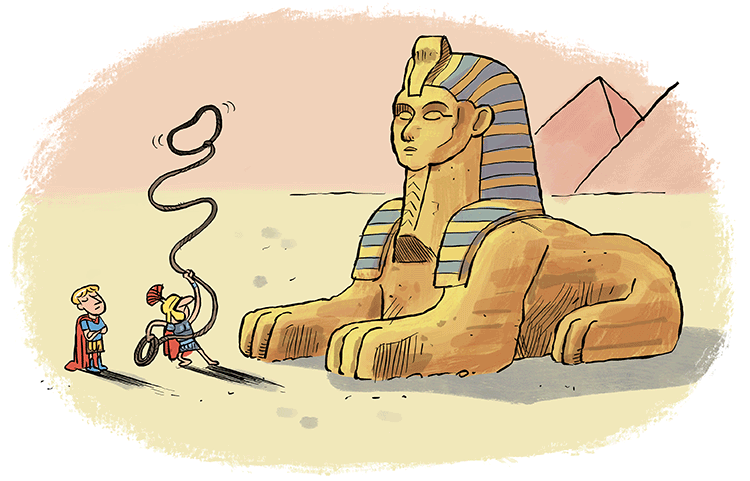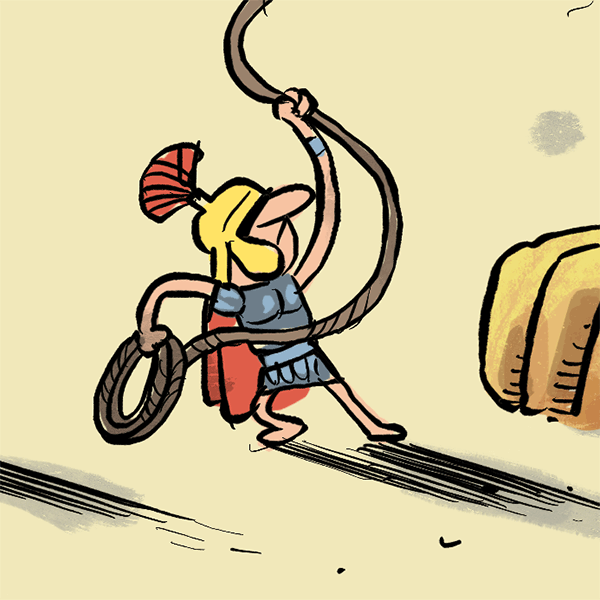The fate of Rome changed forever in 49 BC. That year, a man named Gaius Julius Caesar, after waging civil war, defying the Senate, and crossing into Rome in charge of an army, was named dictator perpetuo, or dictator for life.
This title gave him near complete control over Rome, ending the era of the Republic and launching the Roman Empire.
Some people didn’t like this, however, and Caesar was assassinated just five years later. This infuriated the people of Rome, for they loved Caesar, and another civil war broke out.
This time, from the ashes emerged Julius Caesar’s nephew and adopted son, Octavian. Taking the name Augustus Caesar upon his victory, was made Rome’s first ever official emperor.
Given how much the people had loved his uncle, Octavian sought to honor his legacy and also establish his own rule more firmly by taking a new name. From that point on, the name “Caesar” became the Roman title for emperor and a way for future rulers to connect themselves to the man who came first.
Upon becoming Caesar, one of the first things Augustus did was to “deify” his adopted father, i.e. turn him into a god. He did this because Caesar had the support of the people. Augustus knew that winning it from them would still have to be done through Julius, whether alive or dead.
Combining Two of Rome’s Great Families
As time wore on and new people took control over Rome, it remained vital to be able to trace your lineage back to Julius Caesar. This close relation between Rome’s first emperors gave rise to its first dynasty, the Julio-Claudian Dynasty.
The name came from the roots of two family names: Julius and Claudius.
Julius refers back to Gauis Julius Caesar, the famous one who was instrumental in ending the Roman republic and launching the empire, and who was also the great-uncle and adopted father of Augustus Caesar. But since Augustus’ two sons both died before him, he did not have an heir. So, he appointed his stepson, Tiberius. Tiberius was from the Claudius family. But Augustus had married his mother, and in Rome, adopting a son was the same as having one.
This formally brought the two families together, and the next three emperors (Caligula, Claudius, and Nero) could all trace their ancestry back to this group.
Even if they weren’t related by blood, adoption made their relation official and all part of the same family. This was all an attempt to connect back to Augustus and Julius Caesar, a move designed to help legitimize someone’s imperial claim.
In fact, no one in the Julian-Claudian line had a son of their own. They instead chose to adopt and appoint someone else’s children as their successor. This tradition continued throughout the history of the Roman empire. But more often than not, when that person came from the same family, things didn’t work out.
Instead, Rome was at its best when outgoing emperors chose the next leader based on merit and ability not blood. There were a few exceptions, cases where blood relatives held things together. But in general, keeping things in the family didn’t usually work out.
Nevertheless, throughout the history of the Roman empire, there was always an attempt to keep things in the family. And as the “first family,” these five leaders laid the groundwork for the new Rome as it expanded its imperial and territorial reach across the Mediterranean.
Consolidating Power
Being the first emperors in Rome, the Julio-Claudians were responsible for continuing Rome’s transition from a republic to an empire. There were still many people throughout Rome who did not like the way its government was changing. Establishing a truly firm grip on power would therefore require effort.
Augustus Caesar took this task seriously and did a number of things to solidify his grip on power.
By raising taxes in the provinces, and funneling those funds directly to his offices and not the Senate, he raised money for his armies and administrators, both of which were prepared to carry out the will of the emperor throughout the lands Rome claimed.
Winning the Army
In addition, Augustus Caesar, as well as several of his successors, raised salaries for soldiers and also created a pension fund for them, moves designed to strengthen the support of the military. The armies could often influence who took power, and so winning their affection was key to a stable rule.
The Julian-Claudian emperors, particularly Augustus and Claudius, helped win over the provinces by granting Roman citizenship to the people living there. This gave them a voice in the government and also certain privileges and rights, often related to land. This helped establish the concept of citizenry that is still around today, the idea that being a citizen affords you certain rights and protections from the government.
All of this helped win support for the idea that Rome was better off ruled by just one person, or as close to it as possible. This allowed the first five emperors of Rome to pass power down to their hand-chosen successor, keeping their legacy intact and transforming Rome along the way.
Protecting the Emperor
Force helped too. One thing Augustus Caesar really figured out was that ruling Rome required some muscle. To get it, he established Rome’s first standing armies, as well as the Praetorian Guard, which had the sole purpose of protecting the emperor.
These moves made him considerably more powerful, to the point that when he handed power over to his adopted son Tiberius, the transition took place with little to no noise at all.

Expanding Rome and Installing Peace
When Augustus Caesar first took his position in 27 BC, the Roman provinces were in turmoil. Throughout the previous two hundred years, the Roman republic had expanded its reach considerably. But in the absence of any real political infrastructure, as well as the ongoing civil wars between Rome’s leaders, these provinces were hardly loyal to Rome.
During Augustus’ time as emperor, he successfully annexed Egypt and Hispania (modern Spain), as well as several regions in central Europe. This dramatically expanded the empire’s reach.
Later, under Caligula and Claudius, the empire grew to include Britain in the west and Turkey and modern Israel and Lebanon in the east.
This expansion was possible, and successful, because of the empire-building done throughout the Julian-Claudian era.
Many of these regions were already at least indirectly subjected to Rome. But by consolidating power into the hands of the emperor, it became easier to administer them. This brought greater benefits to the people living there, which made them more willing to accept Roman rule, bringing peace and stability to these regions. which made annexation a more powerful exercise.
Building Rome
The Julian-Claudian emperors also embarked on a number of public works projects, the most notable being the network of roads that brought the vast reaches of the empire closer to one another.
Under Augustus, an imperial courier system was developed to improve the efficiency of communication throughout the empire. Later, his successors would build canals to bring water to the empire.
Claudius was instrumental in the construction of Ostia, Rome’s port. Situated inland on the Tiber River, Rome does not have direct access to the ocean. But thanks to the construction of Ostia, it became infinitely easier to access trade.
Ships no longer had to make the journey up the river and instead could stay along the coast. This improved access to resources, particularly grain, which mostly came from Egypt, and boosted trade, making everyone a little richer.
By focusing on these domestic improvements, this early group of emperors (though most of the credit goes to Augustus and Claudius), helped centralize power in Rome and made expansion possible, a solid foundation upon which future emperors would continue to build.
A Paranoid Bunch
As is often the case when it comes to powerful people, the Julian-Claudian dynasty was responsible for its own demise.
Starting with Tiberius, the first emperor after Augustus, things already started going downhill. Perhaps intimidated by the role, Tiberius ruled from the background and eventually withdrew from public life. This cast considerable doubt on the ability of the Julian-Claudians to rule Rome.
Tiberius’ successor, Caligula, was known for being paranoid and violent. He used treason trials to put his rivals to death and spent lavishly on games and other forms of entertainment. He was eventually assassinated and Claudius took over.
After a relatively successful rule, he eventually died and turned his position over to his adopted son Nero. Many speculate Claudius was actually killed by his wife, another sign of the damaged stability within the ruling family.
After rumors that he’d killed his mother and brother, and because the Senate had declared him an “enemy of Rome,” Nero committed suicide at just 30-years-old.. And since he didn’t have an heir, upon taking his final breath, he opened the door for a new group to step in and take control of Rome.
The End of the Julian-Claudian Line
The death of Nero severed the connection between Rome’s rulers and Julius Caesar and opened the door for a new dynasty. But thanks to the efforts of this first group of Roman emperors, the Roman republic had officially become a thing of the past. The position of emperor would only grow more powerful throughout the following decades and centuries, allowing Rome the chance to solidify its grip on its territories and exert great cultural influence on Europe, western Asia, and Northern Africa.
However, while the Julian-Claudian line was the first set of Roman emperors and had tremendous influence on the entire history of Rome, most of the credit belongs to Augustus Caesar.
As Rome’s first emperor, he made sweeping reforms in how Rome operated, consolidating power into his hands while also keeping up with the image that the Senate was in control, a move designed to keep the aristocracy at bay while he himself became more powerful. Because of this, many historians consider Augustus Caesar to be one of Rome’s best emperors.
In fact, it would be a long time before Rome had another leader like Augustus, yet the fact his empire remained intact despite the lack of quality leaders that came after him, including those in his own family line, speaks to his influence in shaping the city that went on to shape the world.
Written by Matthew Jones
Illustrated by Jean Galvao
